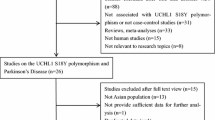Abstract
Based on the observed inverse association between hyperuricemia and Parkinson’s disease (PD) risk, the natural antioxidant activity of uric acid has been suggested to play a protective role. SLC2A9 has been indicated as the most effective of all uric acid transporters, and SLC2A9 variants have been shown to influence circulating uric acid levels. With this study, we aimed to test the association between such SLC2A9 polymorphisms and age at onset (AAO) of PD. Variants rs733175, rs737267, rs1014290, and rs6449213 within SLC2A9 were genotyped in 664 PD individuals from three European centers. The effect of each polymorphism on AAO was estimated within each center using a linear regression model adjusted for gender and genotype at the other SNPs and assuming an additive genetic model. Results across centers were combined using inverse-variance weighted fixed-effect meta-analysis. The minor allele of rs1014290, previously shown to be associated with lower serum uric acid levels, was found to be associated with a lower AAO of PD (pooled estimate −4.56 years; 95% CI −8.13, −1.00; p = 0.012). The association remained significant after adjustment for multiple comparisons and was highly consistent across centers (heterogeneity, I 2 0%). No gender differences were observed. Our study suggests that SLC2A9 genetic variants influence age of onset of Parkinson’s disease.

Similar content being viewed by others
References
Becker BF, Reinholz N, Leipert B, Raschke P, Permanetter B, Gerlach E (1991) Role of uric acid as an endogenous radical scavenger and antioxidant. Chest 100:176S–181S
Caulfield MJ, Munroe PB, O’Neill D, Witkowska K, Charchar FJ, Doblado M et al (2008) SLC2A9 is a high-capacity urate transporter in humans. PLoS Med 5:e197
Church WH, Ward VL (1994) Uric acid is reduced in the substantia nigra in Parkinson’s disease: effect on dopamine oxidation. Brain Res Bull 33:419–425
Dehghan A, Kottgen A, Yang Q, Hwang SJ, Kao WL, Rivadeneira F et al (2008) Association of three genetic loci with uric acid concentration and risk of gout: a genome-wide association study. Lancet 372:1953–1961
Döring A, Gieger C, Mehta D, Gohlke H, Prokisch H, Coassin S et al (2008) SLC2A9 influences uric acid concentrations with pronounced gender-specific effects. Nat Genet 40:430–436
Fedorova L, Fedorov A (2003) Introns in gene evolution. Genetica 118:123–131
Greene CS, Penrod NM, Williams SM, Moore JH (2009) Failure to replicate a genetic association may provide important clues about genetic architecture. PLoS ONE 4:e56
Higgins JP, Thompson SG, Deeks JJ et al (2003) Measuring inconsistency in meta-analyses. BMJ 327(7414):557–560
Hughes AJ, Daniel SE, Kilford L, Lees AJ (1992) Accuracy of clinical diagnosis of idiopathic Parkinson’s disease: a clinico-pathological study of 100 cases. J Neurol Neurosurg Psychiatry 55:181–184
Kolz M, Johnson T, Sanna S, Teumer A, Vitart V, Perola M et al (2009) Meta-analysis of 28, 141 individuals identifies common variants within five new loci that influence uric acid concentrations. PLoS Genet 5:e1000504
Kutzing MK, Firestein BL (2008) Altered uric acid levels and disease states. J Pharmacol Exp Ther 324:1–7
Schwarzschild MA, Schwid SR, Marek K, Watts A, Lang AE, Oakes D et al (2008) Serum urate as a predictor of clinical and radiographic progression in Parkinson disease. Arch Neurol 65:716–723
Vitart V, Rudan I, Hayward C, Gray NK, Floyd J, Palmer CN et al (2008) SLC2A9 is a newly identified urate transporter influencing serum urate concentration, urate excretion and gout. Nat Genet 40:437–442
Acknowledgments
The study was supported by the Ministry of Health and Department of Educational Assistance, University and Research of the Autonomous Province of Bolzano, Italy, the South Tyrolean Sparkasse Foundation, the Deutsche Forschungsgemeinschaft, the PD Foundation/National Parkinson Foundation, the Bundesministerium für Bildung und Forschung, and the University of Lübeck, Germany.
Competing interests
The authors declare that they have no competing interests.
Author information
Authors and Affiliations
Corresponding author
Additional information
Maurizio F Facheris and Andrew A Hicks contributed equally to the study.
Rights and permissions
About this article
Cite this article
Facheris, M.F., Hicks, A.A., Minelli, C. et al. Variation in the Uric Acid Transporter Gene SLC2A9 and Its Association with AAO of Parkinson’s Disease. J Mol Neurosci 43, 246–250 (2011). https://doi.org/10.1007/s12031-010-9409-y
Received:
Accepted:
Published:
Issue Date:
DOI: https://doi.org/10.1007/s12031-010-9409-y




